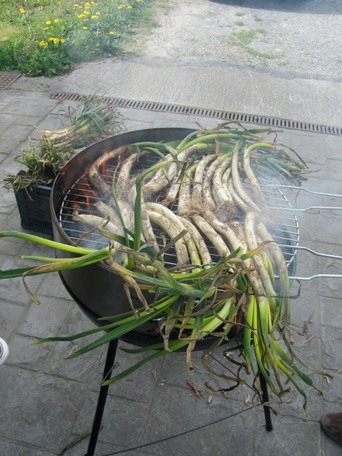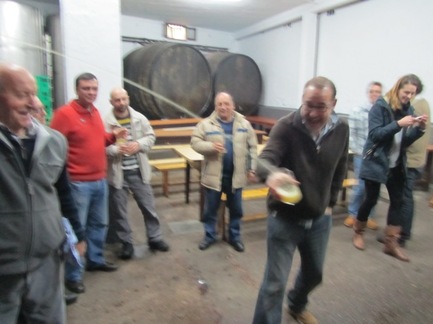After Christmas, when the celebrating’s over, the weather’s not so good, and the earth isn’t yielding up its usual plethora of delights, the Spanish don’t by any means desist from their usual eating, drinking and socialising pursuits, but they do seem to need to make an extra effort to keep things going by organising elaborate winter food and drink rituals.
We’ve been very fortunate in that we’ve recently been introduced to a couple of these by some of Pietro’s lovely post-doctoral research colleagues.
So yesterday we went to a Catalan spring onion party – which the Catalans call a ‘calçotada’. This is a party where folk gather to consume barbecued ‘calçots’ (pr. ‘cal-SOTS’), which are a variety of spring onions which are extremely popular in Catalunya when they are in season in – you guessed it – the spring. Calçots are like normal spring onions except that, as they grow, the depth of soil is increased so as to lengthen the tender white parts at the bottom.
We’ve been very fortunate in that we’ve recently been introduced to a couple of these by some of Pietro’s lovely post-doctoral research colleagues.
So yesterday we went to a Catalan spring onion party – which the Catalans call a ‘calçotada’. This is a party where folk gather to consume barbecued ‘calçots’ (pr. ‘cal-SOTS’), which are a variety of spring onions which are extremely popular in Catalunya when they are in season in – you guessed it – the spring. Calçots are like normal spring onions except that, as they grow, the depth of soil is increased so as to lengthen the tender white parts at the bottom.
At the calçotada, you cook the onions over charcoal and dried vine shoots until they are charred.
After the onions have cooled down for a couple of minutes, you hold one by the top and pull down and remove the charred outer layer, revealing the tender and delicious flesh inside. You then dip the onion into a pot of special calçot salsa made from tomato, nuts, garlic and oil, dangle it into your mouth and eat. It’s very messy but very delicious! And then you have as many more as you want. (Our party divided between onion-sceptics who had only one or two, and onion-embracers (like me) who had 20 or more!)
If you’re lucky (we were), this will be accompanied by the Catalan favourite, ‘pa amb tomaquet’, (bread with tomato), which is bread rubbed with soft tomato, garlic and olive oil. Simple but utterly delicious.
This event was organised by one of the Catalans who work in the lab, who brought the onions and the sauce back with him from a trip back home. It took place in a house on a farm in the village of Lezama, a few miles from Bilbao, where one of Pietro’s colleague’s lives.
Here's a little video (from YouTube) of the big spring onion fiesta in Valls, Catalunya, complete with Catalans in fetching red hats:
http://www.youtube.com/watch?v=cDoJlP_0_BE
Here's a little video (from YouTube) of the big spring onion fiesta in Valls, Catalunya, complete with Catalans in fetching red hats:
http://www.youtube.com/watch?v=cDoJlP_0_BE
And now - a cider party...
A month or so ago, a couple of Pietro’s Basque colleagues organised a traditional Basque winter event - a coach trip to a ‘sagardotegia’ (cider-house) near San Sebastian for a Saturday lunchtime 'txotx', a sort of cider-tasting gathering with lunch.. This took place in the town of Astigarraga, the centre of cider-making in the Basque Country. There are many cider-houses in the town (and many more in the wider San Sebastian area), and people come in coach-loads from the surrounding area during the cider season (December-March, after the apples have been harvested in the autumn.)
A month or so ago, a couple of Pietro’s Basque colleagues organised a traditional Basque winter event - a coach trip to a ‘sagardotegia’ (cider-house) near San Sebastian for a Saturday lunchtime 'txotx', a sort of cider-tasting gathering with lunch.. This took place in the town of Astigarraga, the centre of cider-making in the Basque Country. There are many cider-houses in the town (and many more in the wider San Sebastian area), and people come in coach-loads from the surrounding area during the cider season (December-March, after the apples have been harvested in the autumn.)
In the traditional cider-houses, you find tables set up in the cellars of the farmhouses where the cider barrels ('kupelas') are kept.
There’s no heating, it’s all pretty basic – just excellent cider and hearty country food. The food is the same whichever cider-house you go to, a sequence of favourite simple Basque dishes: ‘tortilla’ (Spanish omelette)’ followed by ‘bacalao’ (cod) followed by ‘chuleta’ (steak), followed by ‘queso, membrillo y nueces’ (Idiazabal cheese, quince paste and walnuts).
Every few minutes, the owner of the cider-house shouts 'txotx' (pr. chotch, a bit like 'church'), and you get up from the table and queue up to get some cider from the barrel. When the valve is open, the cider streams out in an arc and you have to catch it in your glass in mid-air; someone is queuing directly behind you to catch the stream as soon as you have finished with it. You end up with cider all over the floor, of course, but that’s all part of the experience!
Catching the cider at a distance is done to aerate it (Basque cider is not fizzy and much more like scrumpy than British bottled cider). You are also supposed to take only a small amount of cider each time – maybe half a centimetre’s depth – and go back frequently during the meal. (Here is a picture of yours truly playing his part in the ritual....)
And here's a little video of the cider house experience (taken from YouTube):
http://www.youtube.com/watch?v=6XHGpr595PI
http://www.youtube.com/watch?v=6XHGpr595PI
The Spanish generally drink small amounts very slowly. Anything as big as a pint of beer is unheard of. If you want a large beer you ask for a ‘caña’, which is probably about two-thirds of a pint. But a caña will last you a long time. In general, I’d say that a Spanish person will drink three times less than a British person in the same amount of time! Consequently, they don’t get drunk (except very occasionally at fiestas.) (These are of course generalisations but….).
It was interesting therefore to see what happened to Pietro’s young Spanish and Basque colleagues at this event. Because of the routine of taking a small amount of cider and drinking it quite quickly before it loses its fizz, and then going back for more every 5 minutes or so during the meal, we must have ended up drinking a pint of cider in an hour or so – a relatively large amount, relatively quickly, for the Spanish! Consequently, quite a few of them got drunk quite quickly and quite uncharacteristically.
We then all went on to an Irish pub in the nearby town of Hernani where they proceeded to get even more drunk on quite small amounts of beer. (There are Irish pubs everywhere, by the way: you know the kind of thing - not really Irish at all but with an Irish name and vaguely British pub-like décor. There’s one in Bilbao called ‘Mor o’r Less’!).
I am not much of a drinker, but I drank at least as much as everyone else and remained entirely sober! I looked on as amusing and occasionally mildly riotous scenes of drunkenness developed, and several people had to take ‘time out’ to sober up. Eventually a chaotic return to Bilbao was made at about midnight, by which time everyone had calmed down.
In true Spanish style, after a day of eating and drinking which had started at lunchtime, we were then entreated to go on to ‘Rasputin’, the Russian bar in the new town, for vodka cocktails….
It was interesting therefore to see what happened to Pietro’s young Spanish and Basque colleagues at this event. Because of the routine of taking a small amount of cider and drinking it quite quickly before it loses its fizz, and then going back for more every 5 minutes or so during the meal, we must have ended up drinking a pint of cider in an hour or so – a relatively large amount, relatively quickly, for the Spanish! Consequently, quite a few of them got drunk quite quickly and quite uncharacteristically.
We then all went on to an Irish pub in the nearby town of Hernani where they proceeded to get even more drunk on quite small amounts of beer. (There are Irish pubs everywhere, by the way: you know the kind of thing - not really Irish at all but with an Irish name and vaguely British pub-like décor. There’s one in Bilbao called ‘Mor o’r Less’!).
I am not much of a drinker, but I drank at least as much as everyone else and remained entirely sober! I looked on as amusing and occasionally mildly riotous scenes of drunkenness developed, and several people had to take ‘time out’ to sober up. Eventually a chaotic return to Bilbao was made at about midnight, by which time everyone had calmed down.
In true Spanish style, after a day of eating and drinking which had started at lunchtime, we were then entreated to go on to ‘Rasputin’, the Russian bar in the new town, for vodka cocktails….

















 RSS Feed
RSS Feed